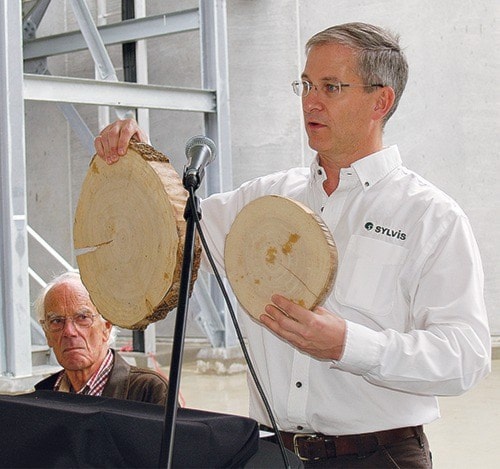While the poop is literally hitting the fan up at Vancouver Island University’s 1,700-hectare forest woodlot on Weigles Road in Nanaimo, the trees and their value in terms of lumber are growing in leaps and bounds.
The university and the Regional District of Nanaimo partnered with Sylvis, a Lower Mainland environmental consulting company, to manage the roughly 4,000 tonnes of biosolids produced annually at the RDN’s pollution control centres in Nanaimo and French Creek to be used for VIU’s Biosolids
Fertilization Project.
Originally used for cover at the regional landfill, the biosolids – a nutrient-rich, humus-like sludge that results from the treatment of liquid waste – has been applied to VIU’s woodlot since 2002 to enhance tree growth.
Silvis became part of the project in February and Mike Van Ham, company president, calls it the ultimate in recycling.
“So often we’re told we have to stop doing this or that … we simply have to discontinue something and that doesn’t solve anything,” he said.
“What we’re doing is capturing the inherent value of the biosolid material and putting it back into the environment to solve problems.”
But the effect on a forest lacking quality conditions for growth is what is amazing VIU researchers, who documented tree growth from 50 to 400 per cent.
“We’re right near the top of two watersheds. One way is the Benson Creek/Millstone watershed and the other is the Jump Creek watershed,” said Paul Lucas, VIU woodlands superintendent.
“It’s known as a shedding site with not a lot of nutrients in the soil. On top of that, 10,000 years ago glaciers scraped this pretty smooth and left shale and sandstone soil.”
Marise Wickman, VIU silviculture forester for the woodlot, said the biosolids enhance the soil and create a substantial increase in growth by helping retain water on the moisture-stressed site.
Lucas said since the introduction of biosolids the university has tripled its tree growth from 244 cubic metres per hectare to 760 cubic metres per hectare. That increases the value of the forest from $15,000 per hectare to $45,000 per hectare.
Fifty hectares per year are covered in 20 dry tonnes of biosolids using a modified side discharge manure spreader with a three-paddled hydraulic fan. The spreader throws the biosolids up to 30 metres under and over the canopy of trees.
The application of biosolids over the years struck a nerve with recreational users of the land, even though 1,000 hectares of it is leased by VIU from TimberWest and another 700 acres is Crown land.
Ashley Ahrens, project coordinator with Sylvis, said working with the community is vital.
“We’ve been talking with the Nanaimo Mountain Bike Club on a regular basis and monthly we send them records of what areas were applied and areas that will be applied,” she said. “We have maps of their trails so we work with them making sure we don’t apply on their trails.”
Mark Perdue, Nanaimo Mountain Bike Club landowner liaison director, said he’s encouraged with the working relationship with VIU and Sylvis.
“We realize we are guests on the land and they have nothing more than a moral duty to work with us,” he said. “But they’ve tried to minimize the effect to the point where they’ve not put in a road in an effort not to hit our trails.
“There’s still some solutions needed on some issues, but we’re working together so everyone can benefit.”
